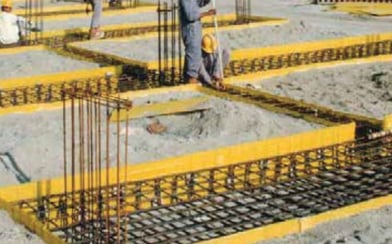Sacrificial formwork, also known as permanent formwork, is designed to be left in place once concrete has been poured. As a result, it may contribute to the load carrying capacity of the structure or may simply be relied on to contain the concrete while it is being cast. Sacrificial formwork is often used in places where it is difficult or impossible to remove the formwork after the pour.
Broadly speaking, there are three different types of sacrificial formwork. These are:
- “Flat sheet” - usually consists of a steel wire mesh with a heat shrunk layer of polyethylene applied to both sides of the mesh. For example - Form “N” Fill and Pecaform.
- Expanded mesh - rather than polyethylene, corrugated sheet metal and mesh are utilised. For example - RibForm.
- Steel decking - roll-formed steel decking sections which clip together to create permanent formwork.
All three types of formwork are easy-to-use, robust and lightweight. In this post, we are specifically taking a look at flat sheet formwork.

How can flat sheet formwork be used?
For pile caps and bases, the process of applying flat sheet formwork is as follows;
- Excavate as per requirements of foundation
- Install reinforcement cage and provide necessary spacing from the base allow for the concrete cover
- Place formwork around perimeter of the reinforcing using deck rail chairs or suitable spacers to provide the correct cover from the reinforcing. Tie the formwork to the reinforcing using tie wire or similar.
- Backfill around the formwork.
- Pour and vibrate concrete
- Formwork remains in the ground
Flat sheet formwork can also be used for ground beams, construction joints, void formation, waffle slabs, recesses, temporary fencing and safety screens.
Whilst a number of benefits can be found when using this type of formwork, there are two key circumstances when it is absolutely ideal to use. These being:
- There is a tight project timeline
- The concrete needs to be poured in unstable soil
Let’s explore these circumstances in more detail.
1 . There is a tight project timeline
Conventional formwork is time-consuming to assemble and adds to the workload on site. In addition to this, it requires specialised labour and tools to complete.
In comparison, flat sheet permanent formwork is considerably faster as it removes the need for extensive bracing. This is because the formwork is flush up against the soil and minimal to no bracing is required. Flat sheet formwork is both strong and flexible, the galvanised wire having a tensile strength of around 485 N/mm2.
Economies of scale can be achieved by the use of composite construction where the formwork becomes an integral part of the completed structure. There is a cost and time saving multiplier effect, especially in projects where there are multiple pours. Imagine a project that requires 10 x 10 metre pylons. If relying on conventional formwork, the cost/time required is blown out by each cubic metre and multiplied over each pylon.
No skilled labour is required and the formwork can be delivered to site ready for assembly or it can be simply folded on site using manual labour. No specialist tools are required, just simple hand tools and tie-wire.
2 . The concrete needs to be poured in unstable soil
Excavating loose or unstable ground can result in over excavation where walls of trenches or beams collapse during excavation. With the price of concrete continuing to rise, minimising concrete usage is imperative.
The process of constructing a concrete structure on unstable soil can be costly due to the need for additional bracing and excessive soil removal. It is also common for additional concrete to be poured in order to reinforce foundations which further increases project costs.
Flat sheet formwork is very effective for projects being constructed on unstable soil. Once the sacrificial formwork is in place, the excavated soil can then be backfilled on the outside of the form with no or minimal need for rod/timber bracing. This braces the formwork sufficiently and makes it ready for the concrete pour, even though the soil is unstable.
The use of flat sheet formwork in unstable ground conditions not only significantly reduces concrete usage; it also ensures that the foundations are sized correctly according to the engineer’s specifications.
Need more expert advice on formwork? Talk to the team at Allcon
We’re a family business with over 100 year’s collective experience in specialist concrete construction products, so we know the hard truths about concrete. Call us on 1300 255 266. Or click here to get in touch.
